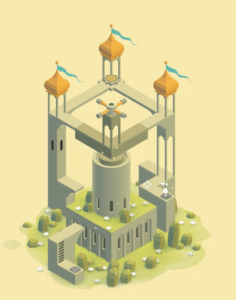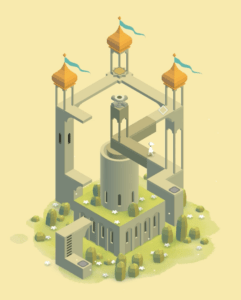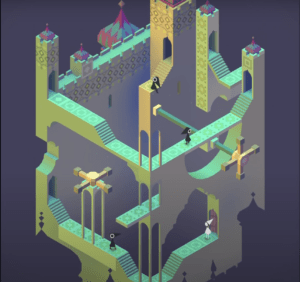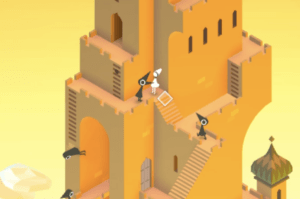Monument Valley is an atmospheric puzzle game developed by Ustwo Games in 2014. It is playable on iOS, Android, and Windows (I played on my Windows PC) and is suitable for all ages, yet there may be some puzzles within the game that can cause frustration for younger players.
Central Argument
Monument Valley can be identified by its stunning colors and use of geometric structures in an open space – with an embedded narrative told through level completion and where the destination didn’t matter, only the journey. The game’s mechanics, particularly the limited interactivity and stress-free environment, influence the player’s experience by emphasizing discovery and sensation over the traditional challenge or narrative depth of gaming, thereby creating a unique, visually-driven journey through its levels.
Limited and Simplistic Gameplay
When a player enters Monument Valley, the essential mechanics of movement are clicking on the path where Ida should walk to and rotating knobs or repositioning sliding blocks to create paths. This is all you need to complete the game. You cannot make Ida walk faster than her current pace, which is relatively slow, as one click can take her to where she needs to be. Ida’s freedom to roam is limited to just the paths laid out for her, so her movement is restricted to the inherent maze in the puzzle as clicking elsewhere renders null. With such limited mechanics for interacting with the world, the game ultimately focuses the player’s attention on the exploratory elements of the game – the rotating knobs or sliders. These blocks, often highlighted with additional identifiable animations, can completely change the scenery and the player’s perception of the puzzle through optical illusions, generating new paths that can lead the player directly to the next level. This creates a dynamic of interactive curiosity where the player actively looks for cogs or anything they can move to prompt and discover a level change. Since Monument Valley manipulates perspective, the player is unable to predict the resulting change in paths and is invited to test multiple positions. That unpredictability is exactly what adds to the thrill of the game and appeals to the aesthetic of discovery.


This argument is supported by another mechanic, or perhaps the lack of one – there are no visual cues for the end and beginning of a level. This means there are no clear exit symbols or passageways that the player knows will lead to another level. In the image below, I encountered a structure with multiple doorways, yet the second one I entered advanced me to the next scene, which was a recurring theme in the game. This excitement from the unpredictability of every path or entry further appeals to discovery, sparking feelings of hope and anticipation that the next door I enter would be the last one. No clear start or end to a level meant the goal wasn’t even to win – it was to experience the scene you’re currently in.

Cultivating a stress-free environment
In creating a stress-free environment with the absence of traditional challenges like enemies, time limits, fail states, or redo options, Monument Valley encourages not just exploration but contemplation of its atmospheric scenes and optical illusions. The game makes use of space for that matter, where structures are zoomed out and players are surrounded by a warm ambiance rather than a crowded maze with adrenaline-fueled puzzles. The visual components of the game are aligned with the sound effects, with no sudden visual changes or noises. This atmospheric minimalism invites the player to focus and reflect on the immediate experience, to which I even questioned the previous state of the structure I was in and turned the knob a couple more times than needed when encountering optical illusions. Despite not having level completion rewards or stars to rate your performance, Monument Valley stands out in the sensation it brings to its players by treating the experience as the reward.

Points of Consideration
What Monument Valley gains in sensation and discovery, however, it lacks in balanced challenge and narrative depth. The embedded narrative of the game was broken up into aesthetic fragments that were intended for atmospheric purposes rather than creating a narrative. There were multiple cutscenes that emphasized narrative but the build up was more on the artistic side rather than the depth of the narrative itself, which was not fully revealed at the end of the game. The environmental storytelling was beautiful throughout, but the player’s and my own incentive for helping Ida was not established. When I played, I soon lost track of the narrative after waiting between lengthy cutscenes for the puzzles – the narrative was overshadowed and forgotten by the 6th level for me, and I no longer bothered to read it.
My main concern with the puzzle is its ease of completion until later levels with more winding paths, which alludes to a lack of initial player choice. The player can only click on the path that Ida can walk on, which means for every level, the player is already on the correct and intended path. The earlier puzzles felt linear, as I did not have to retrace my steps until later levels when there were more path options and, thus, more player choice in exploration and freedom to attempt. With no redo button in the game, I am aware that the game’s intentions are mainly for the experience rather than an outright challenge. However, there are only 10 levels, all of which I completed in around an hour. Perhaps this is only a matter of adding more levels to better scale the difficulty, or simply adding more unique components like the tall yellow block Ida could stand on. With such charming imagery, I wish the game had given us more chances to explore.



